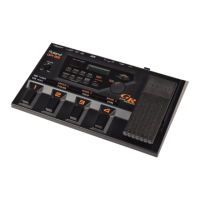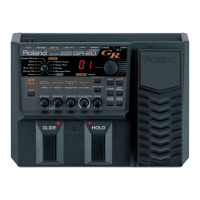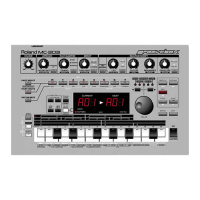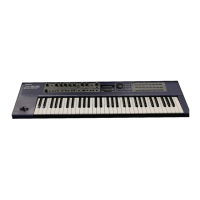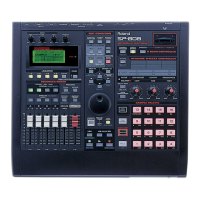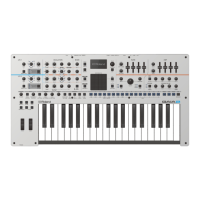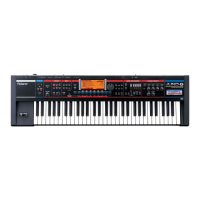Guitars differ from keyboards and other instruments
in that the part of the instrument that actually vibrates
(i.e. the string) is touched directly, allowing subtle
control of the power with which it is played. To let
the guitar synthesizer make maximum use of this fea-
ture, it is necessary to set the “playing response.”
This selection is made with “PLAY FEEL” in the
COMMON setting. For example, by changing the
Play Feel options like “finger picking” or “normal
picking,” you can get very natural-sounding expres-
sion of how much power is in the playing.
<Changing and Recording Play Feel>
1. Select the patch, and press [EDIT/PLAY] to go
into the Edit mode.
2. Set the EDIT TARGET dial to COMMON, and the
PARAMETER SELECT dial to “B” (PLAY FEEL).
3. With the [+] and [-] buttons, change the values in
the range shown under ◆ below.
4. When you get it set to sound the way you like,
switch the PARAMETER SELECT dial to “WRITE
PATCH?”, and press the [+] and [-] buttons simul-
taneously to write the patch.
➼
When saving to another patch number, before step 4,
turn the PARAMETER SELECT dial to “WRITE
TO...”, and use the [+] and [-] buttons to designate a
patch number as the destination.
◆ There are eight types of effect that can be
selected in step 3.
Select one of the following: “nor”; “Fin”; “Hrd”;
“SFt”; “tAp”; “no.d”; “EF1”; or “EF2”; then when you
press the [+] button, a period will appear in the dis-
play, right after the last digit of the selected setting
(“nor.”; “Fin.”; “Hrd.”; and so on), and the selection is
set. (In the “Accelerator” function mentioned later,
the period indicates that the function is on. See p. 38.)
Display names and meanings are as follows:
nor (normal)
General picking, thus the standard setting for play.
Fin (finger picking)
The setting for when you want to perform with the
feeling finger picking provides. Sensitivity is a lit-
tle higher than with normal picking.
Hrd (hard picking)
This setting is for those who pick rather hard, and
the sensitivity is a little lower than with normal
picking.
✽
When there is a problem with the guitar’s arrangement,
and the only places GK-2A’s divided pickup can be
installed are too close to the strings, you may be able to
improve the behavior with the settings in each patch.
SFt (soft picking)
For picking that is a little weaker. Sensitivity is a
little higher than with normal picking.
tAP (tapping play)
When making use of many kinds of picking tech-
niques, such as tapping play (or “right-hand
play”), pulling-off, or hammering-on, this setting
provides very stable sound expression. The range
of power that can be expressed is a bit narrow.
no.d (no dynamics)
With this setting, no matter how hard or softly you
play, you get uniform volume and tone. Use this
setting with tones like Synth Lead or Organ when
you want to transmit a feeling without expression.
EF1 (envelope follow type 1)
This is for setting how much the synthesizer vol-
ume influences the amplitude of the strings. (For
more detailed information about this, see the fol-
lowing section.)
EF2 (envelope follow type 2)
This is for setting how much the overall tone
(brightness) influences the amplitude of the
strings. (For more information about this, see the
following section.)
✽
Picking strength and power range vary from player to
player. The names of these settings (“normal,” “hard,”
and so on) are for easy reference only, so you are encour-
aged to actually switch through the settings, and when
you find ones that you feel are easy to play, that you feel
have characteristics of instruments you’d like to play,
paying no special attention to their names, go ahead and
select those settings.
For example, by choosing “Fin” for picking the Synth
Lead tone, and “tAP” for an organ-type sound, you can
convey imagery when you play, and it’s no problem
since it’ll be easy to play.
37
5
Changing the Feel of a Performance (PLAY FEEL)

